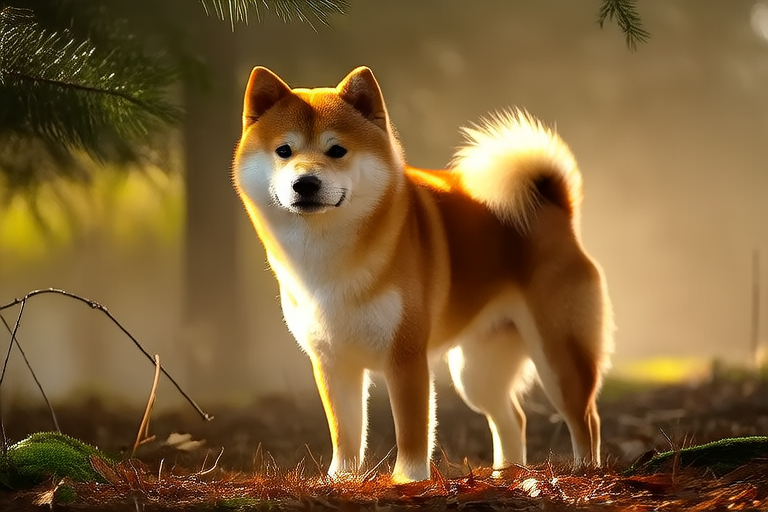The Evolution of the Shiba Inu: From Ancient Wolves to Cherished Lap Dogs
The Shiba Inu, a small yet sturdy Japanese breed, has a rich history that spans thousands of years. Originating in the mountainous regions of Japan, these dogs have evolved from their wild wolf ancestry into beloved companions. This article delves into the journey of the Shiba Inu, exploring its historical context, genetic traits, cultural significance, and modern-day characteristics.
Origins and Early History
The Shiba Inu’s roots trace back to ancient Japan, where they were initially bred for hunting purposes. Their name, “Shiba,” translates to “brushwood” or “small,” referring to their size and agility in navigating through dense vegetation. The term “Inu” simply means “dog.” These dogs were essential for hunting birds and other small game, and their keen sense of smell made them invaluable in the rugged terrain of Japan’s mountains.
The earliest records of Shiba Inus date back to the Jomon period (14,000 BCE – 300 BCE), when they were likely domesticated from wolves. Over time, they became integral to Japanese culture, symbolizing loyalty, courage, and resilience. Despite their diminutive size, Shibas were highly valued for their hunting prowess and ability to withstand harsh weather conditions.
Genetic Traits and Adaptation
The Shiba Inu’s genetic makeup is a testament to its evolutionary journey. They possess several key traits that set them apart from other breeds:
- Compact Build: Shibas are known for their compact, muscular bodies, which allow them to move swiftly and efficiently in tight spaces. Their short legs and deep chest enable them to navigate through dense forests with ease.
- Dense Coat: Their double coat provides excellent insulation against cold temperatures, making them well-suited for life in Japan’s mountainous regions. The outer coat is straight and coarse, while the undercoat is soft and thick.
- Erect Ears: The Shiba Inu’s triangular ears stand erect, enhancing their hearing abilities. This trait is particularly useful for detecting prey and potential threats in their surroundings.
- Distinctive Markings: Shibas are often characterized by their reddish-brown coats, white markings on the chest, legs, and tail, and black-tipped tails. These distinctive features have been selectively bred over generations, contributing to the breed’s unique appearance.
Through centuries of selective breeding, the Shiba Inu has adapted to various environmental challenges, including harsh winters and rugged terrains. Their genetic traits have enabled them to thrive in diverse settings, from rural villages to urban environments.
Cultural Significance
In Japanese culture, the Shiba Inu holds significant symbolic value. They are often associated with loyalty, courage, and perseverance, qualities deeply ingrained in Japanese society. Shibas have been featured in numerous works of art, literature, and folklore, further cementing their place in the nation’s cultural heritage.
During World War II, the Shiba Inu faced near extinction due to bombings and disease outbreaks. However, dedicated breeders worked tirelessly to preserve the breed, ensuring its survival for future generations. Today, the Shiba Inu remains an important part of Japanese culture, celebrated for its resilience and enduring spirit.
Transition to Companion Animals
The transition of the Shiba Inu from working dog to companion animal began in the mid-20th century. As hunting practices declined and urbanization increased, Shibas found new roles as beloved family pets. Their intelligence, independence, and affectionate nature made them ideal companions for city dwellers and suburban families alike.
Despite their small size, Shibas require regular exercise and mental stimulation to stay healthy and happy. Owners must provide opportunities for physical activity, such as daily walks or playtime in a secure area. Additionally, Shibas benefit from mental engagement through puzzle toys or training sessions. Proper socialization during puppyhood is crucial for developing well-rounded, confident dogs.
Modern-Day Characteristics
Today, the Shiba Inu is recognized worldwide for its distinctive appearance and charming personality. They are known for their independent streak, which can sometimes be mistaken for stubbornness. Shibas are intelligent dogs that enjoy problem-solving and learning new tricks. Owners should approach training with patience and consistency, rewarding good behavior with treats and praise.
Shibas are also known for their vocalizations, which include barking, whining, and howling. While this trait may be undesirable for some owners, it serves as a form of communication between the dog and its human companions. Understanding the reasons behind their vocalizations can help owners address any underlying issues and foster a stronger bond with their pets.
Despite their small size, Shibas are surprisingly adaptable and can thrive in various living situations. They are well-suited for apartment living, provided they receive adequate exercise and mental stimulation. Shibas are generally quiet indoors and can coexist peacefully with other pets if properly introduced.
Conclusion
The Shiba Inu’s journey from wild wolf ancestry to cherished lap dog is a testament to the power of selective breeding and cultural preservation. Over centuries, these dogs have adapted to changing environments, evolving into loyal, intelligent companions that bring joy to millions of households around the world. As we continue to celebrate their unique characteristics and contributions to our lives, let us also honor their rich history and cultural significance.
